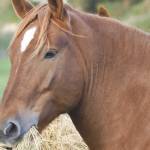Feeding Horses with Special Needs

Horse owners tend to equate good appetite to good health. Though this is often the case, some horses with a hearty appetite may require dietary changes because of a condition that can be aggravated by a misguided feeding program. These conditions may include equines with airway disease or laminitis.
In horses with inflammatory airway disease or heaves, signs of illness are related to exposure to airborne allergens (dusts, molds, fungi) and endotoxins. Changes in feeding and housing management are essential for long-term control of these conditions. Ideally, affected horses are housed outside or in well-ventilated barns with ample daily turnout. If housed indoors, bedding must be dust-free (shredded paper, wood chips). Hay is a primary source of allergens, including molds and fungi. The hay should either be removed from the diet or fed only after thorough soaking, which involves completely immersed in a tub of water for a minimum of five minutes. Hay cubes are an alternate fiber source, but these should also be soaked in water prior to feeding.
A common cause of laminitis is overconsumption of starch and sugars, found in grains and lush pasture. The problem occurs when a large amount of undigested starch or sugar passes into the hindgut and undergoes bacterial fermentation. A primary goal in the prevention of recurrences is elimination of grain or pasture from the diet. These animals should be fed hay, a vitamin-mineral supplement and, if needed, a fat supplement such as rice bran, or vegetable oil. However, in many ponies and some horses, chronic active laminitis is associated with obesity and gradual weight loss is necessary.
Older horses with Cushing’s syndrome are also prone to laminitis, and persistent insulin resistance is common in aged horses. Accordingly, nutritional management of affected horses should also emphasize restriction of grain and lush pasture intake. EquiShure stabilizes pH levels in the hindgut, preventing the changes in bacterial populations that trigger laminitis in some horses.
Owners who are uncertain about the best way to feed their horses with airway disease, laminitis, or Cushing’s syndrome should download a copy of “Nutritional Management of Metabolic Diseases” or contact a KER equine nutrition advisor for advice.








